San Diego Electric Vehicles Growth
Written by Andrey Gunawan and Pourya Shamsi, editors of IEEE TEI Newsletter
This article is written based on part of the presentation given by Lee Krevat at the IEEE Transportation Electrification Initiative and Arizona State University’s (ASU) LightWorks Lecture Series, ASU SkySong in Scottsdale, AZ, October 28, 2013. Lee Krevat is the director of the smart grid and clean transportation for San Diego Gas & Electric (SDG&E).
SDG&E operates on the distribution and transmission levels, which supplies more than 1.4 million electric meters as well as 861,000 gas meters, serving more than 3 million people in 25 cities in Southern California. SDG&E is dynamically facing new challenges on smart grids and transportation electrification due to its geological location. Over 225 MW of distributed generation, which are mostly Photovoltaic (PV), are installed within the operation range of SDG&E. Additionally, this company supplies electricity to more than 6,000 plug-in hybrid and electric vehicle (EV) drivers in their territory.
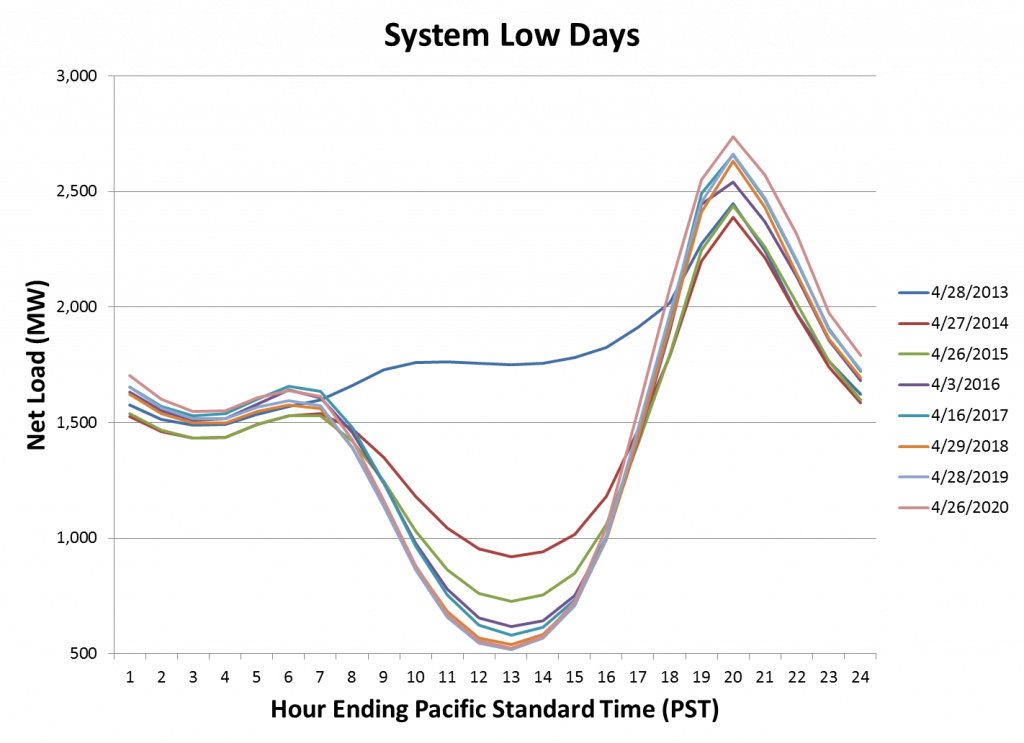 |
| Figure 1 - Demand, net of renewable energy low day illustration |
SDG&E has been observing new challenges introduced to the grid as the result of mass integration of renewable energy sources and plug-in hybrid electric/electric vehicles. Due to the large power demand of EV chargers, the current structure of the distribution network can suffer from overloads. Each EV charger can introduce a power demand equivalent to two residential units (homes). Hence, the current residential distribution networks cannot cope with mass integration of the home charging stations during peak hours. On the other hand, increasing the number of distributed generation from PV will lead to severe technical challenges in dealing with the load ramp during late afternoon and early evening (see Figure 1). Due to the natural generation cycle of PV cells, these sources lose their generation capacity by early evening. By integrating more solar generation, not only the evening peak load remains the same, but also a significant portion of the generation is lost when the sun goes down. Furthermore, EVs can introduce a new peak energy demand, which leads to higher load demands that translates to a steeper ramp at the neck of the duck curve (Figure 1). Therefore, SDG&E is planning to introduce methods to mitigate the peak demand of the grid by using the EV charging power demand. Flexible EV chargers can charge EVs during the hours when generation from renewable energies is high. SDG&E plans to encourage customers to charge the EVs in the “belly” of the duck-shaped graph. During these hours, a large amount of solar energy generation results in a small amount of net demand observed by the grid. Hence, adding the EV charging demand during the high solar generation hours can smooth the load profile.
SDG&E has experimented with special time-of-use energy pricing in San Diego for the past three years. Using this pricing, SDG&E has been able to place 80% of residential charging between midnight and 5 AM. Although this technique has been successful for guiding the charging habit to the midnight hours, new procedures for daytime charging is still required. New generations of plug-in hybrid electric vehicles will benefit from small battery capacities that provide nearly 15 miles of pure electric propulsion. With the traditional habit of charging, commuting to work will be on the pure electric mode while return trip will be with the gas engine. Consequently, introduction of mid-day charging can not only benefit the grid, but also eliminate gas propulsion during the return trips. SDG&E is developing various pilot programs in order to promote mid-day charging.
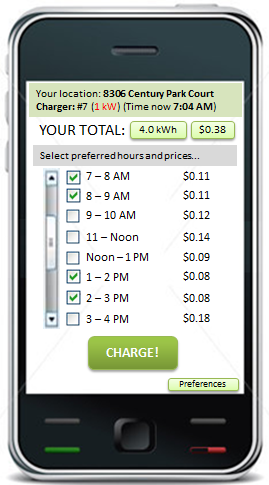 |
| Figure 2- Dynamic Pricing smartphone application |
One of the pilot programs has developed a new smartphone application (Figure 2) that enables users to select the best mid-day charging profile based on their preferences. This application is capable of interfacing with multi-unit dwelling and workplace charging stations. The user can input the parking place number where the EV is parked. Using the application, the charger will also ensure a minimum charge set by the user is available by the pick-up time. In addition, the user can set a price limit. If the price of electricity falls below this set value, the charger will charge up the EV. Hence, this application will not only guarantee the minimum required charge, but also saves the users’ money by charging at the best pricing scenarios. Moreover, the application can optimize the charging price by selecting various charging hours in the advanced menus. The system can optimize the overall charging cost based on the availability of the EV in the charging station. If the user wants to leave in a short time, the minimum energy will be transferred to the vehicle. However, if the user selects flexible charging hours in the application, the system will optimize the charging process for the minimum cost. This system will not only benefit the user by reducing the charging cost, but also benefits SDG&E by gaining management over the charging hours and eliminate unnecessary expansion of the grid infrastructures.
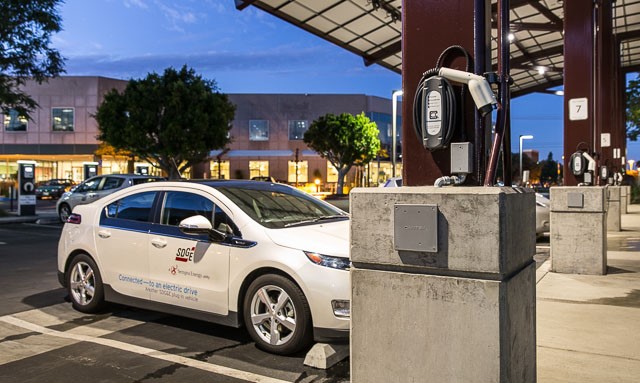 |
| Figure 3- Workplace charging solutions at SDG&E |
In order to explore various mid-day charging procedures, SDG&E has built a charging station (Figure 3). This station is located at the SDG&E headquarters for use by employees. The system will charge the vehicle based on the available energy within the grid. Therefore, grid-integrated charging stations can reduce the stress over the grid and help with smoothing the load profile. In this system, after the EV is parked, the user can log into the system and the system will look up the vehicle’s info and the best charging profile based on the information available in the user’s cloud profile. Afterwards, the system will optimize the charging process. The charger will go on and off throughout the day to ensure the best price. Moreover, the user can dynamically monitor the status of the charger, using the smartphone application. They will be aware of the state-of-charge in the vehicle. This system has been operating successfully and SDG&E is hoping to one day make this technology available to their San Diego customers.
Additionally, SDG&E worked with Smart City San Diego, a collaborative organization involving SDG&E, the city of San Diego, Cleantech San Diego, UC San Diego and GE to design and implement the solar-to-EV charging stations at the San Diego Zoo parking lot (Figure 4). Ten solar canopies and 5 PEV chargers with a total solar generation power of 90 kW have been installed in the parking lot. In addition, a battery takes energy from the solar system to be able to charge the grid and the EVs with clean energy during the night. This project helps removing 189,216 lbs. of CO2 from the atmosphere each year, and visitors to the Zoo have provide much positive feedback to see such a project at this destination spot.
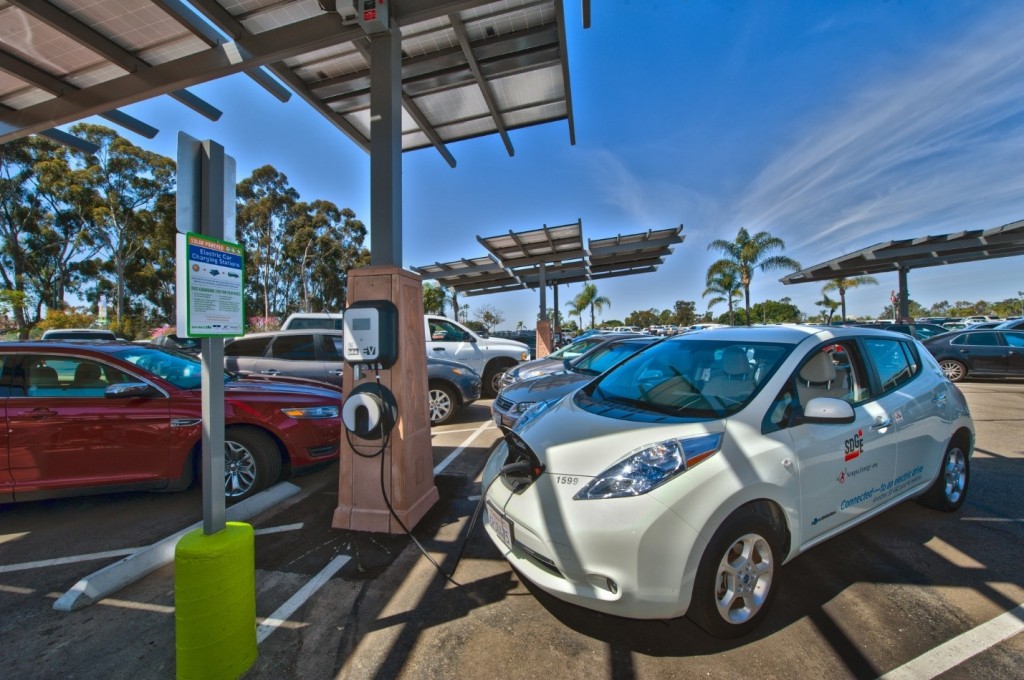 |
| Figure 4 - Solar-to-EV project at the San Diego Zoo: efficient integration with the grid (with storage) |
 Andrey Gunawan
Andrey Gunawan
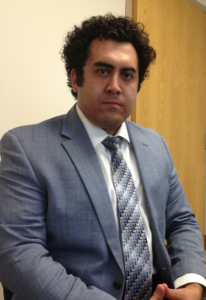 Pourya Shamsi received his BSc and PhD from University of Tehran, Iran, and The University of Texas at Dallas, Texas, respectively. He was the chief R&D engineer of PSP Co., Iran, for six years. He was a post-doctoral research associate at the University of Texas at Dallas. Currently, he is an assistant professor of Electrical Engineering at Missouri University of Science and Technology.
Pourya Shamsi received his BSc and PhD from University of Tehran, Iran, and The University of Texas at Dallas, Texas, respectively. He was the chief R&D engineer of PSP Co., Iran, for six years. He was a post-doctoral research associate at the University of Texas at Dallas. Currently, he is an assistant professor of Electrical Engineering at Missouri University of Science and Technology.
He is mainly focused on applications of power electronic converters in smart micro-grids. Moreover, he has worked on modern drive systems for transportation electrification. His research interests include but are not limited to smart grids, distributed generation, modeling and stability analysis of power electronic converters, V2G, motor drives, and high frequency power conversion. He has several patents and publications in peer reviewed journals and conferences. He is also a reviewer for many journals in the area of power electronics and energy systems.
About the Newsletter
Editors-in-Chief

Jin-Woo Ahn
Co-Editor-in-Chief

Sheldon Williamson
Co-Editor-in-Chief
TEC Call for Articles 2023 - Advances in Charging Systems
The TEC eNewsletter is now being indexed by Google Scholar and peer-reviewed articles are being submitted to IEEE Xplore.
To submit an article click here.


